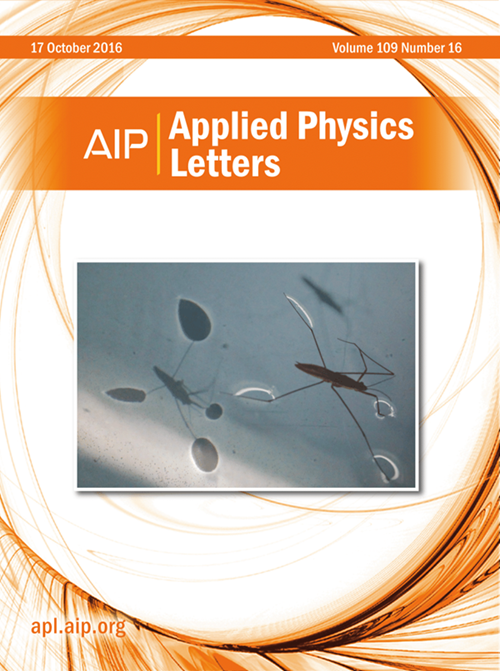Design of Au urchin embedded in PMMA: A solution to balance photoresponse and dark-current for WS2 plasmonic photodetectors
IF 3.5
2区 物理与天体物理
Q2 PHYSICS, APPLIED
引用次数: 0
Abstract
The local surface plasmon resonance effect has made an outstanding contribution to high-performance optoelectronic devices due to its unique light absorption ability. However, it is urgent to solve the accompanying problem of high dark-current, which is mainly caused by interface damage and charge transfer between plasma structure and material. In this work, we designed a plasma structure of Au urchin embedded in the PMMA layer to effectively balance photo-response and dark-current for WS2 plasmonic photodetectors (PDs). Herein, the non-contact “metal–semiconductor” integration prevents free electron injection and avoids the carrier lifetime extension caused by interfacial defect, which guarantees low dark-current and high carrier mobility of WS2. In particular, compared to conventional spherical metal nanoparticles, the multi-tip Au urchin allows better light absorption enhancement and accelerated carrier separation, as confirmed by finite-difference time-domain simulations. As a result, the WS2/PMMA@Au urchin plasmonic PD achieves 3.6-fold reduction in dark-current, thus obtaining a high responsivity of 533 A/W, a detectivity of 1.46 × 1010 Jones, and an ultra-fast response speed of 136 ns. Our proposed plasma structure provides a way for promoting weak-light detection and high-efficiency photoelectric conversion of low-dimensional optoelectronic devices.金胆嵌入PMMA的设计:WS2等离子体光电探测器光响应和暗电流平衡的解决方案
局部表面等离子体共振效应以其独特的光吸收能力为高性能光电器件做出了突出的贡献。然而,伴随而来的高暗电流问题亟待解决,这主要是由等离子体结构与材料之间的界面损伤和电荷转移引起的。在这项工作中,我们设计了一种嵌在PMMA层中的Au海胆等离子体结构,以有效地平衡WS2等离子体光电探测器(pd)的光响应和暗电流。其中,非接触式“金属-半导体”集成防止了自由电子注入,避免了界面缺陷导致的载流子寿命延长,保证了WS2的低暗电流和高载流子迁移率。特别是,与传统的球形金属纳米颗粒相比,多尖端金海胆具有更好的光吸收增强和加速载流子分离的能力,这一点得到了时域有限差分模拟的证实。结果表明,WS2/PMMA@Au海胆等离子体PD的暗电流降低了3.6倍,从而获得了533 a /W的高响应率、1.46 × 1010 Jones的探测率和136 ns的超快响应速度。我们提出的等离子体结构为促进低维光电器件的弱光探测和高效光电转换提供了一种途径。
本文章由计算机程序翻译,如有差异,请以英文原文为准。
求助全文
约1分钟内获得全文
求助全文
来源期刊

Applied Physics Letters
物理-物理:应用
CiteScore
6.40
自引率
10.00%
发文量
1821
审稿时长
1.6 months
期刊介绍:
Applied Physics Letters (APL) features concise, up-to-date reports on significant new findings in applied physics. Emphasizing rapid dissemination of key data and new physical insights, APL offers prompt publication of new experimental and theoretical papers reporting applications of physics phenomena to all branches of science, engineering, and modern technology.
In addition to regular articles, the journal also publishes invited Fast Track, Perspectives, and in-depth Editorials which report on cutting-edge areas in applied physics.
APL Perspectives are forward-looking invited letters which highlight recent developments or discoveries. Emphasis is placed on very recent developments, potentially disruptive technologies, open questions and possible solutions. They also include a mini-roadmap detailing where the community should direct efforts in order for the phenomena to be viable for application and the challenges associated with meeting that performance threshold. Perspectives are characterized by personal viewpoints and opinions of recognized experts in the field.
Fast Track articles are invited original research articles that report results that are particularly novel and important or provide a significant advancement in an emerging field. Because of the urgency and scientific importance of the work, the peer review process is accelerated. If, during the review process, it becomes apparent that the paper does not meet the Fast Track criterion, it is returned to a normal track.
 求助内容:
求助内容: 应助结果提醒方式:
应助结果提醒方式:


